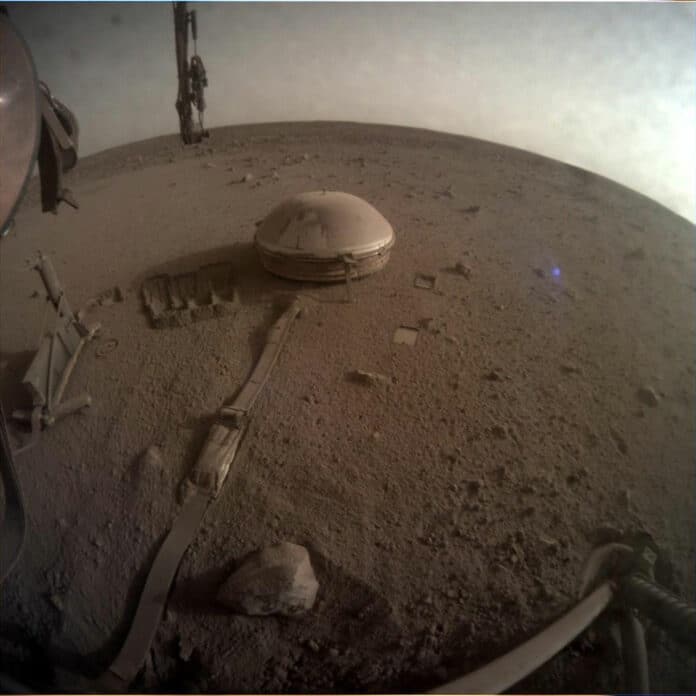Mars has a liquid iron alloy core at its center. Formed early in Mars’ history, the core is an iron alloy rich in light elements, with sulfur proposed as the main light element based on Martian meteorite geochemistry.
Now, using seismic data gathered by the InSight mission, a new study by the University of Bristol made the first observations of seismic waves traveling through Mars’ core. Seismic wave measurements reveal that the planet’s liquid core is smaller and slightly denser than previously assumed and is made up of a mixture of iron and many other elements.
The results suggested Mars‘ core is slightly denser and smaller than previous estimates, with a radius of approximately 1,780–1,810 km. These findings are consistent with the core having a relatively high fraction of light elements alloyed with iron, including abundant sulfur and smaller amounts of oxygen, carbon, and hydrogen.
In 2018, the InSight lander placed a broadband seismometer on the Martian surface, making it possible to track seismic phenomena like marsquakes and meteorite strikes. The multidisciplinary team of researchers, which included seismologists, geodynamics, and mineral physicists, used observations of two seismic events in the hemisphere opposite that of the seismometer to calculate the relative travel times of seismic waves that left the mantle and those that entered the core.
The research mission’s results are all the more impressive, considering that it was initially only intended to endure for about one Mars year (two Earth years). NASA prolonged the InSight Mars lander’s stay despite Martian storms speeding up dust buildup and cutting out power, so geophysical data, including signals from marsquakes, remained to be collected until the end of the previous year.
Lead author Dr. Jessica Irving, Senior Lecturer in Earth Sciences at the University of Bristol, said: “The extra mission time certainly paid off. We’ve made the first observations of seismic waves traveling through the core of Mars. Two seismic signals, one from a distant marsquake and one from a meteorite impact on the far side of the planet, have allowed us to probe the Martian core with seismic waves. We’ve effectively been listening for energy traveling through the heart of another planet, and now we’ve heard it.”
“These first measurements of the elastic properties of Mars’ core have helped us investigate its composition. Rather than just a ball of iron, it also contains a large amount of sulfur and other elements, including a small amount of hydrogen.”
“So-called ‘farside’ events, meaning those on the opposite side of the planet to InSight, are intrinsically harder to detect because a great deal of energy is lost or diverted away as waves travel through the planet. We needed both luck and skill to find and then use these events. We detected no farside events in the first Martian year of operations. If the mission had ended, then this research couldn’t have happened.”
“The Sol 976 marsquake was the most distant event found during the mission. The second farside event, S1000a – the first event detected on day 1,000 of operations – was particularly useful because it turned out to be a meteorite impact which we heard through the planet, so we knew where the seismic signals came from. These events came after the Marsquake Service (MQS) had honed their skills on hundreds of days of Martian data; it then took a lot of seismological expertise from across the Insight Team to tease the signals out from the complex seismograms recorded by the lander.”
Co-author Ved Lekic, Associate Professor of Geology at the University of Maryland College Park, in the US, said: “Detecting and understanding waves that travel through the very core of another planet is incredibly challenging, reflecting decades of efforts by hundreds of scientists and engineers from multiple countries. We not only had to utilize sophisticated seismic analysis techniques but also deploy knowledge of how high pressures and temperatures affect properties of metal alloys, leveraging the expertise of the InSight Team.”
Dr. Irving added: “The new results are important for understanding how Mars’ formation and evolution differ from Earth‘s. New theories about the formation conditions and building blocks of the red planet will need to be able to match the core’s physical properties as revealed by this new study.”
Journal Reference:
- Jessica C. E. Irving, Vedran Lekić et al. First observations of core-transiting seismic phases on Mars. PNAS. DOI: 10.1073/pnas.2217090120
